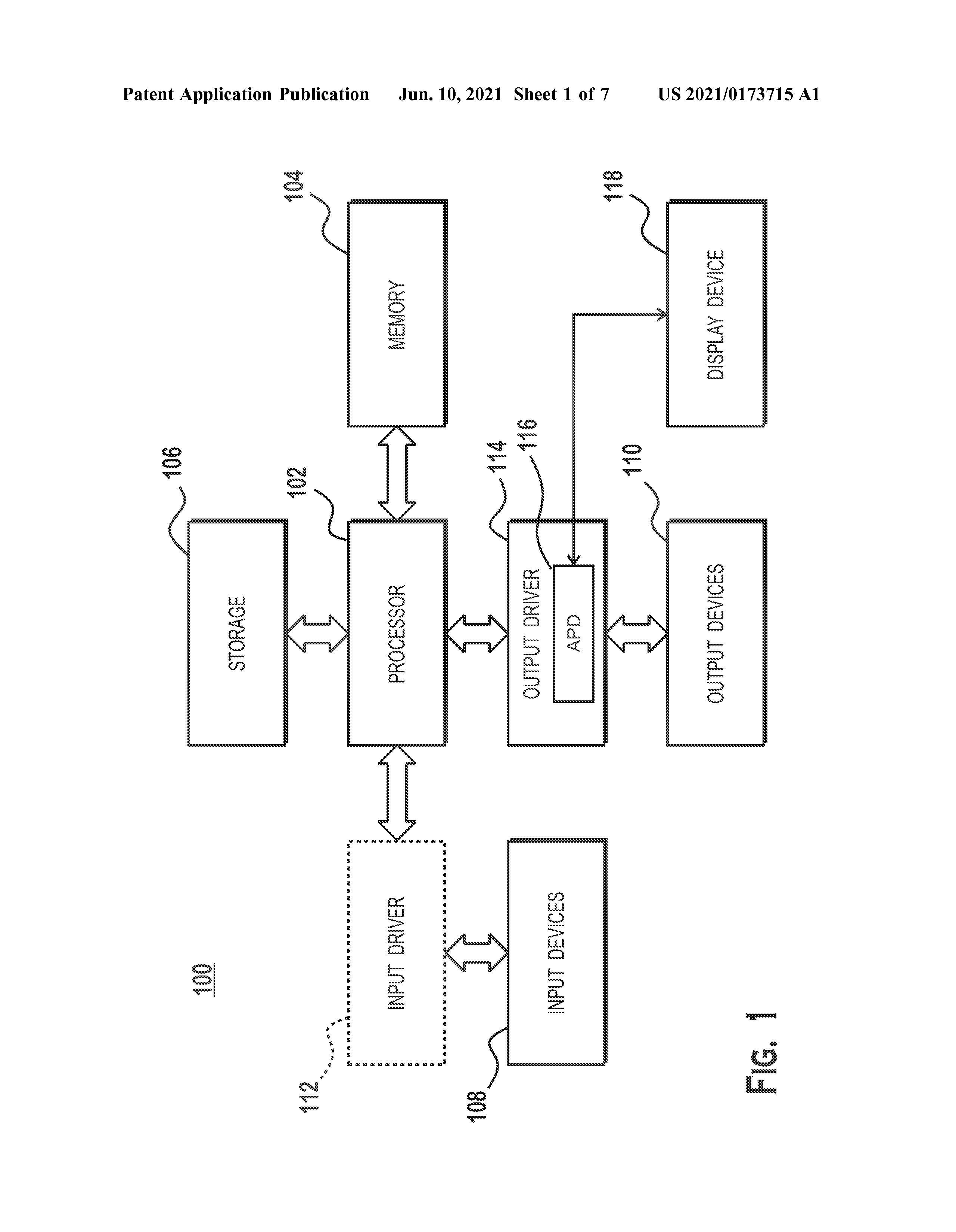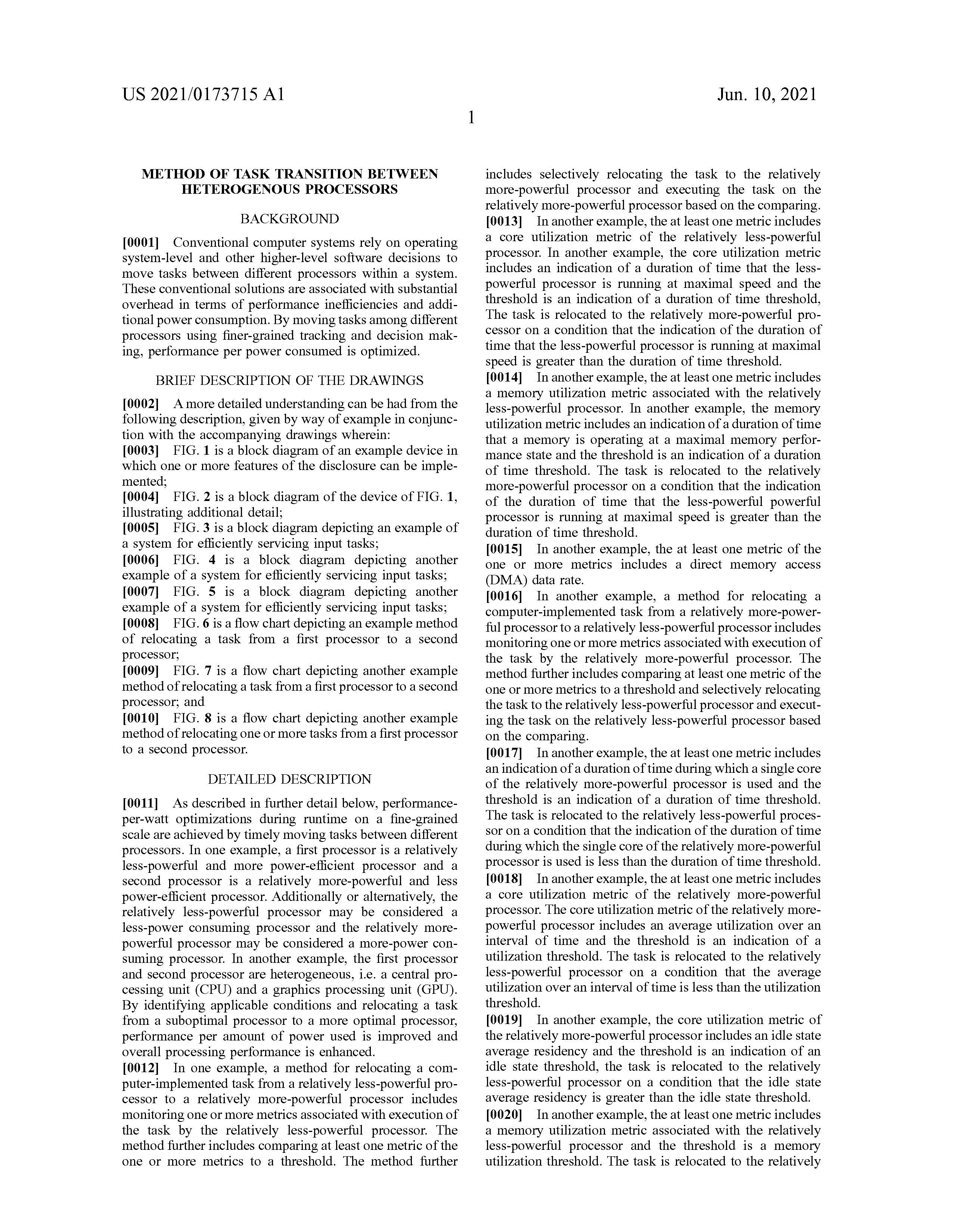AMD Patent Hints At Hybrid CPU To Rival Intel's Raptor Lake CPUs
Twitter user Kepler has discovered a new AMD patent application that details moving tasks (threads) between different types of cores in a heterogeneous processor. In other words, the patent lays the groundwork for a microarchitecture that resembles Arm's big.LITTLE design that uses clusters of 'big' high-performance cores paired with 'little' efficiency cores.
AMD files over a plethora of patent applications every year, so there's no guarantee that all of them will manifest as real products. That said, there are plenty of reasons to think that we could see a hybrid AMD design come to market. Intel has already embraced a hybrid design on its desktop parts with the upcoming 12th-Gen Alder Lake family, and it's reasonable to assume that AMD will eventually hop on the hybrid bandwagon at some point in time.
Although the Method of Task Transition Between Heterogeneous Processors patent application was just published a couple of days ago, AMD filed it back in 2019. This patent may be an extension of a similar application that AMD also filed in the same year about implementing instruction set architecture (ISA) in a heterogeneous processor.
There's an ongoing rumor that AMD's Ryzen 8000 (reportedly codename Strix Point) APUs could arrive with a hybrid setup. The chips allegedly feature high-performance Zen 5 cores and low-powered Zen '4D' cores. Unless AMD has been diligently working behind the scenes, it's unlikely that Strix Point will make it to the market in time to compete with Intel's Alder Lake chips that may launch in late 2021 or early 2022. However, the APUs will probably go head-to-head with Raptor Lake, the alleged successor to Alder Lake.
















The patent explains that the process to relocate a task or tasks from the first processor to the second processor will be based around performance metrics based on certain thresholds or some other trigger. AMD didn't specify which cores are which, but for the sake of conversation, we can assume that the first processor refers to the big cores and the second processor refers to the power-efficient cores.
Obviously, the whole point behind a hybrid configuration is to optimize performance-per-watt while also improving performance. To achieve this goal, tasks must be moved quickly and efficiently between the big and small cores. AMD's method consists of comparing one or multiple metrics to a threshold on a checklist to determine whether or not to pass the task from one processor to another. Once the assessment is complete, the first processor essentially pauses operations while the information is transferred over to the second processor.
AMD mentions numerous examples of the type of metrics that the chipmaker could leverage for the task relocation process. The chipmaker mentions task execution time, core utilization, memory usage, idle state of a single core, or duration of a single-core execution - just to mention a few scenarios.
Get Tom's Hardware's best news and in-depth reviews, straight to your inbox.
In one example, AMD measures the period of time that the small cores are running at the maximal clock speed and compares it to a threshold. If the duration is greater than the established time threshold, the task shifts over to the bigger cores. In another example, AMD takes into account an external factor: memory. If the memory utilization is less than the threshold established on the small cores, the task will remain on said cores.
Hybrid processors won't succeed unless there is proper software support. Recent rumors point to a new, more efficient scheduler in Windows 11 that's optimized for hybrid setups. That new update is rumored to land later this year at the same time as Alder Lake, which should pave the way for better support for hybrid processors.

Zhiye Liu is a news editor, memory reviewer, and SSD tester at Tom’s Hardware. Although he loves everything that’s hardware, he has a soft spot for CPUs, GPUs, and RAM.
-
hotaru.hino Seems like hybrid processors in PC space are the future after all.Reply
Granted you could say that Zen 2/3 is already power efficient, given that if I use Power Saver on Windows, the CPU cores sit at around <5W according to HWiNFO. -
ezst036 At first I was not happy with the idea of hybrid processors. My thought has been why would I want so many(16 or 32 say) cores when half or more may be small cores when I could have a full 32 big core goodness? The small cores, I don't really want them.Reply
However over the last year with manufacturing capacity issues being so front and center I suspect the writing is on the wall. And if there's more than 10 or 12 big cores anyways then its probably alright to have other small ones along for the ride. I've come to accept this.
The reality of fab capacity woes kind of make big little inevitable. -
everettfsargent "The chips allegedly feature high-performance Zen 5 cores and low-powered Zen '4D' cores. Unless AMD has been diligently working behind the scenes, it's unlikely that Strix Point will make it to the market in time to compete with Intel's Alder Lake chips that may launch in late 2021 or early 2022. "Reply
Ba ha ha ha ha ...
First, Alder Lake just has to substantially beat the 5950X across the board. Period. Full stop. Anything short of that, and we already know that the type of workload will determine Alder Lake's success at heterogeneity and success at efficiency. In other words, it is bound to be a dog in certain workloads wrt 5950X (the reverse of this, for AMD, not so much so imho). Oh and Intel may announce a PR laden Q4 launch day, but we all know that that means Q1 2022 as readily available in the retail channel to end users as tray or boxed parts. -
littlechipsbigchips This is good for notebooks and tablets , but I dont see it go anywhere in desktops and workstations.Reply -
escksu Replylittlechipsbigchips said:This is good for notebooks and tablets , but I dont see it go anywhere in desktops and workstations.
It will work for desktops and workstations and even servers. You have to look beyond consumer market and look at corporate sector. There are many cases where desktops are used instead of notebooks and many are on 24/7. So, the power savings can be quite substantial. Even servers, they consume alot of power even at idle, esp. when you consider a data center.
So, if by moving certain tasks to power efficient cores, it will help to save power. -
jeremyj_83 Reply
This wouldn't really work on servers as >99% of hosts run hypervisors. The whole idea there being to run multiple smaller virtual servers to maximize the CPU load. In this case you do not want your virtual hosts running at idle most of the time. In fact you want them running 50-75% CPU usage all the time. That will keep your CPU ready percentage low and maximize your investment.escksu said:It will work for desktops and workstations and even servers. You have to look beyond consumer market and look at corporate sector. There are many cases where desktops are used instead of notebooks and many are on 24/7. So, the power savings can be quite substantial. Even servers, they consume alot of power even at idle, esp. when you consider a data center.
So, if by moving certain tasks to power efficient cores, it will help to save power.
For things that don't need the maximum performance, then it could work. Firewalls would probably be a good choice for something like this in the server market. -
Howardohyea Reply
Unless the new i9 12900K have at least 12 big cores and numerous small cores, it won't stand a chance even with the 5950X. Unless Intel's bringing their HEDT cheaper than ever.everettfsargent said:"The chips allegedly feature high-performance Zen 5 cores and low-powered Zen '4D' cores. Unless AMD has been diligently working behind the scenes, it's unlikely that Strix Point will make it to the market in time to compete with Intel's Alder Lake chips that may launch in late 2021 or early 2022. "
Ba ha ha ha ha ...
First, Alder Lake just has to substantially beat the 5950X across the board. Period. Full stop. Anything short of that, and we already know that the type of workload will determine Alder Lake's success at heterogeneity and success at efficiency. In other words, it is bound to be a dog in certain workloads wrt 5950X (the reverse of this, for AMD, not so much so imho). Oh and Intel may announce a PR laden Q4 launch day, but we all know that that means Q1 2022 as readily available in the retail channel to end users as tray or boxed parts. -
NeoMorpheus Go AMD!Reply
Dont let that dirty and anti-consumer company (Intel) to ever get back on top.
Man, I never desired a company to die as much as Intel, well, add Nvidia for the same reasons. -
hotaru.hino Reply
So you want an anti-consumer company to die by way of establishing the anti-consumer practice of having an effective monopoly?NeoMorpheus said:Go AMD!
Dont let that dirty and anti-consumer company (Intel) to ever get back on top.
Man, I never desired a company to die as much as Intel, well, add Nvidia for the same reasons.